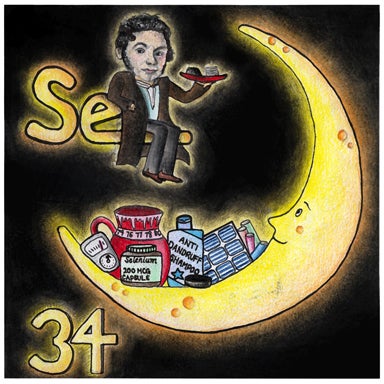University of Toronto Schools, Toronto, Ontario, Canada

Selenium: Selenium was discovered by Jöns Jakob Berzelius in 1817 and was named after the Greek word “selene” meaning "Moon". In his hand, Berzelius is holding all of the three allotropes of selenium, each of which has its own distinct color. The other items found on the moon are the past and present uses of selenium. Currently, the largest use of selenium worldwide is as a pigment in ceramics, but selenium is also the active ingredient in anti-dandruff shampoos (center) and improves abrasion resistance in vulcanized rubbers such as in the hockey puck (lower center). Because of its photovoltaic and photoconductive properties, selenium is used in solar panels and photocells (right). Selenium is also a micronutrient and is needed in small doses in humans daily. It is commercially available as supplements (left). Finally, the five stable, naturally occurring isotopes of Selenium: 74, 76, 77, 78, 80 are placed as a detail… can you find where they are?
Tina Yuan. Teacher Jennifer Pitt, University of Toronto Schools, Toronto, Ontario, Canada
Atomic properties*
* Haynes, W. M. (2011). CRC Handbook of Chemistry and Physics, 91st edition: http://www.hbcponline.com/ Retrieved April 7, 2011
± Winter, M. (2010). Home of the Periodic Table. Retrieved April 8, 2011, from Web Elements: http://www.webelements.com/